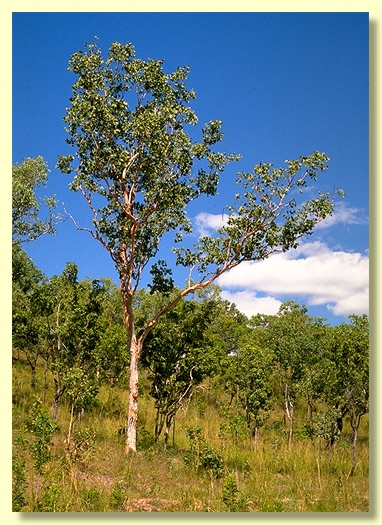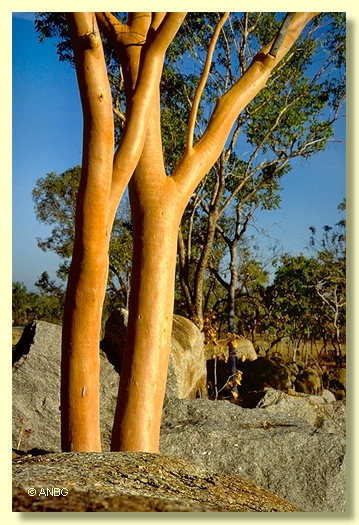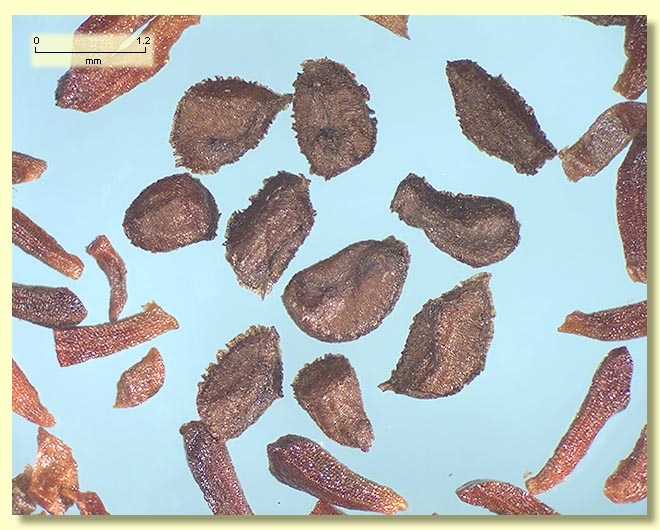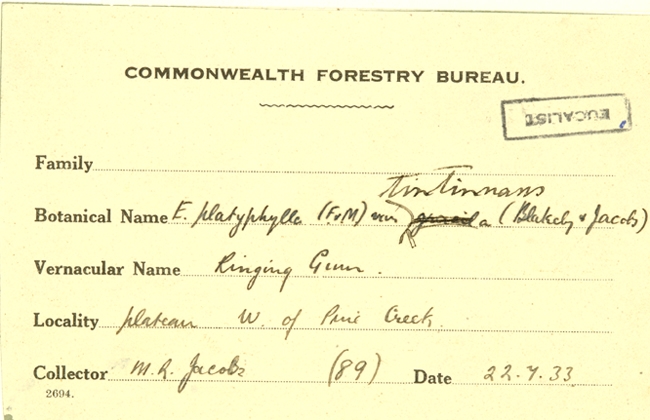Euclid - Online edition
Eucalyptus tintinnans
Eucalyptus | Symphyomyrtus | Exsertaria | Subexsertae | Applanatae
Eucalyptus tintinnans (Blakely & Jacobs) L.A.S.Johnson & K.D.Hill, Fl. Australia 19: 510 (1988).
Eucalyptus platyphylla var. tintinnans Blakely & Jacobs in W.F. Blakely, Key Eucalypts 138 (1934). T: Outlier from plateau 10 miles [16 km] W of Pine Creek, Northern Territory, 27 July 1933, M.R.Jacobs 89; lecto: NSW; isolecto: CANB; fide L.A.S.Johnson & K.D.Hill, loc. cit.
Tree to c. 15 m tall, usually much shorter and often of straggly appearance. Deciduous during the drier months prior to the wet season. Forming a lignotuber.
Bark smooth throughout, new bark pale orange to pale creamy-pink, maturing through brilliant salmon-pink to dull grey-white and weathering to grey just before decortication.
Juvenile growth (coppice or field seedlings to 50 cm) : not seen.
Adult leaves alternate to sub-opposite, petioles 2.5–4.2 cm long; blade orbicular to deltoid to rarely ovate, 5.5–11 cm long, 3.5–6(8) cm wide, base broadly lobed to truncate to rounded to tapering to petiole, margin entire, apex pointed to rounded, concolorous to slightly discolorous, usually dull green to grey-green, side-veins mostly at a wider angle than 45° to the midrib, reticulation dense to very dense, intramarginal vein present, well removed from the margin, but sometimes not well formed in larger leaves, oil glands sparse intersectional or sometimes somewhat obscure.
Inflorescence axillary unbranched, peduncles 0.2–0.6 cm long, buds per umbel 7 or sometimes more than 7, sessile to shortly pedicellate (pedicels 0–0.5 cm long). Mature buds globular, 0.4–0.7 cm long, 0.3–0.6 cm wide, scar present, operculum rounded to shortly beaked (0.1–0.3 cm long), hypanthium sometimes with two longitudinal ridges, stamens usually inflexed, anthers oblong, versatile, dorsifixed, dehiscing by longitudinal slits, style long and straight, stigma blunt, locules (3)4, the placentae each with 6 or more vertical rows of ovules. Flowers white.
Fruit sessile to shortly pedicellate (pedicels 0–0.3 cm long), obconical to hemispherical, non-glaucous, 0.4 cm long, 0.5–0.6 cm wide, disc raised and annular, valves (3)4, near the rim or slightly exserted.
Seeds dark brown, 1–1.5 mm long, ± flattened ovoid to obliquely pyramidal, dorsal surface shallowly reticulate, edge of seed sharply toothed, hilum ventral.
Cultivated seedlings (measured at ca node 10): not seen
Flowering has been recorded in July and September.
A small to medium-sized tree, endemic to the Top End of the Northern Territory. Usually on rises or low stony hills from the Stapleton area just south-east of Darwin, then east to the Kakadu National Park and then south to the Katherine Gorge – Beswick area. Characterised by the smooth, brilliant coloured, newly exposed salmon-pink bark, the deltoid adult leaves, the globular buds and hemispherical to obconical fruit with a raised annular disc.
Eucalyptus tintinnans belongs to a small group of species closely related to the red gums (Eucalyptus subgenus Symphyomyrtus section Exsertaria series Subexsertae subseries Applanatae). Subseries Applanatae is distinguished by having pale smooth powdery bark in season with newly exposed bark uniformly highly coloured, adult leaves with dense to very dense venation and oil glands intersectional, or absent, buds with inflexed stamens, fruit with an annular disc, and more or less flattened, toothed seeds with a ventral hilum. Other members of this group are E. bigalerita, E. platyphylla, E. alba, E. apodophylla and E. houseana.
Within this group, E. tintinnans is closest to E. bigalerita and E. platyphylla because all three species have relatively large deltoid adult leaves. They are weakly separated from each other by the size of the adult leaves, the buds and fruit. (The adult leaves in E. bigalerita are normally wider than 6 cm but narrower than 6 cm in E. tintinnans and the fruit in E. bigalerita and E. platyphylla usually wider than 0.6 cm but 0.6 cm or narrower in E. tintinnans, although some overlap does sometimes occur.) In the Northern Territory, E. tintinnans and E. bigalerita can also be separated by the habitat in which both grow. E. tintinnans is a small tree of the stony hills, while E. bigalerita is normally a well formed tree growing in heavy soils on the lower, flat country. The only other species in this group that may be confused with E. tintinnans is E. alba var. australasica. It can be distinguished by having broadly lanceolate to ovate adult leaves, in contrast to the deltoid or orbicular leaves of E. tintinnans. E. apodophylla and E. houseana are easily separated on adult leaf shape, colour and size. E. houseana has dull, long, lanceolate adult leaves always narrower than 4.5 cm and E. apodophylla has opposite, sessile to very shortly petiolate, glaucous to grey-green adult leaves (E. tintinnans usually alternate, dull green, distinctly petiolate and deltoid).
Because of its distinctly petiolate, deltoid adult leaves, E. tintinnans cannot be confused with any other white gums growing within its area of occurrence, i.e. E. brevifolia, E. glomericassis, E. herbertiana, E. leucophloia and E. umbrawarrensis. All these have smaller or narrower lanceolate to ovate adult leaves.
(The relationships between Eucalyptus alba var. alba, E. alba var. australasica, E. bigalerita, E. hallii, E. platyphylla and E. tintinnans need further investigation. E. alba var. alba, E. bigalerita, E. platyphylla and E. tintinnans are all very similar and the taxonomy, largely based on the size of adult leaves, buds and fruit, does not appear to work across the full range for this group. It maybe better that all four species be placed in one variable taxon, using the oldest name, Eucalyptus alba. Such a revision is beyond the scope of EUCLID, thus we have adopted the current curatorial status for this group.)
Eucalyptus tintinnans: Latin tintinno, make a ringing sound, referring to the sound that many of the hollow trees give out when struck with an axe.


















